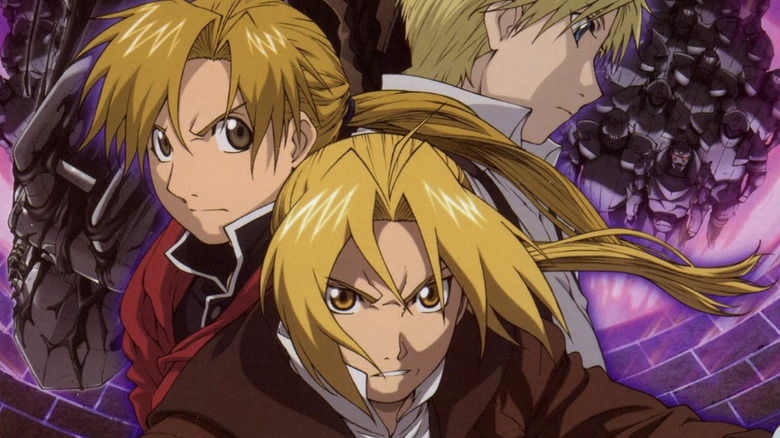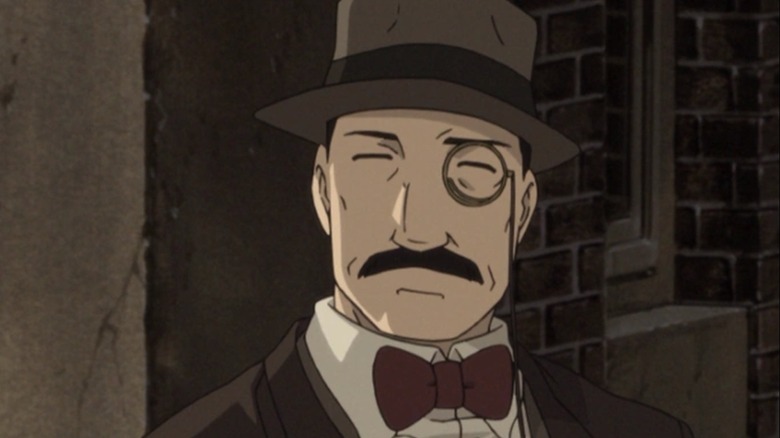This Anime Movie Has One Of The Wildest Director Cameos Ever
We may receive a commission on purchases made from links.
Sometimes film directors step in front of the camera and appear in movies, whether it be cameos in their own work (a tradition popularized by Alfred Hitchcock), or appearances in others' work. Some directors go a step further and let themselves be animated into cartoons (see Zack Snyder and James Gunn's recent appearance on "Rick and Morty").
The most out-there animated filmmaker cameo, though, has to be in "Fullmetal Alchemist the Movie: Conqueror of Shamballa," the epilogue film to the 2003 "Fullmetal Alchemist" anime (not to be confused with the later "Fullmetal Alchemist: Brotherhood").
"Fullmetal Alchemist," based on the manga by Hiromu Arakawa, follows the two alchemist brothers Edward "Ed" Elric and Alphonse "Al" Elric. It's set in a fantasy world, specifically the fictional country of Amestris (modeled on 1910s Europe). But the 2003 anime, which changed a lot from the then-incomplete source material, linked the setting to the real world.
Alchemy comes from a metaphysical object called the Gate of Truth, which holds all the knowledge in the universe. The 2003 anime infers that, if there's a gate, then there must be something on the other side: our world. Near the end of the series, Ed crosses the Gate and winds up in England during World War 1. In the series finale, "Laws and Promises (Munich 1921)," he alchemically transmutes his own body to restore Al's, and wakes up back on the other side of the Gate cut off from his brother and friends.
"Conqueror of Shamballa" picks up two years later in 1923. Ed is living in Munich, studying rocketry and attempting to find a way home. The movie suggests that everyone in the real world is a doppelganger of someone Ed knows back home. His science partner, for instance, is his brother's counterpart, Alfons Heiderich. The film leans on real history, too, and spotlights rising Nazi sentiment in post-WW1 Germany. As the movie shows, 1923 was the year of the "Beer Hall Putsch," Adolf Hitler's first failed attempt to overthrow the Weimar Republic. The main villains are the Thule Society, a real occultist Nazi group. The Thule Society want to open the Gate of Truth themselves and invade the dimension on the other side (hence, "Conqueror of Shamballa").
Not everyone Ed meets is so unfriendly, though. One of Ed's friends in our world is Fritz Lang, a fictionalized version of the famous German filmmaker. Lang is friendly and a mentor to Ed, but he has the face of one of the Fullmetal Alchemist's greatest foes: Führer King Bradley, military dictator of Amestris.
Edward Elric, meet Fritz Lang
Lang was born in Austria-Hungary in 1890. After a youth spent painting, traveling, and then serving in World War 1, he became a pioneer of the German film industry. His work included both silent films (such as 1927 science-fiction epic "Metropolis") and early talkies (the 1931 social thriller "M," starring Peter Lorre as a child murderer and the community afflicted by his crimes). His last German film was 1933's "The Testament of Dr. Mabuse," a sequel to his 1922 film "Dr. Mabuse, The Gambler" (which Ed and Lang discuss in "Conqueror of Shamballa"). By this time the Nazis had seized power, and they banned the film.
Despite that, Hitler and Joseph Goebbels were actually admirers of Lang's films and offered him a job in the Ministry of Propaganda. Lang, who had Jewish ancestry, wisely chose to flee Germany instead: first to France, and then to America. He found consistent work in Hollywood and kept making films through 1960, especially noirs. Some of Lang's most acclaimed English-language films include "Scarlet Street" and "The Big Heat."
In a booklet included with the limited edition DVD of "Conqueror of Shamballa," writer Shō Aikawa says Lang's inclusion was initially "a service to fans" — "I wondered what people who admired Lang would think when they saw the movie." As the story kept being written and rewritten, Lang took up the burden of delivering exposition, as Aikawa thought "there really wasn't anyone else who existed in Germany that could represent the times and be connected to both rocketry and the Nazis, except for Lang." (Lang's 1929 science-fiction film "Woman in the Moon" influenced real ideas of rocket travel).
Lang shares voice talent with Führer Bradley; Hidekatsu Shibata in the original Japanese, Ed Blaylock in the English dub. During "Fullmetal Alchemist," Bradley also wears an eyepatch, just as Lang did in real life. (He lost sight in his right eye from a war wound, though the movie gives him a simple monocle.) The obvious irony of linking them is that Lang, an opponent of the Nazis and Hitler, is the counterpart to the Führer of another world. Bradley has a moustache just like Hitler did, too.
However, Fritz Lang's presence in "Conqueror of Shamballa" isn't just a historical in-joke. It ties into the film's themes of fantasy in contrast to reality. The movie questions how you can live your life if you're always chasing dreams — and Lang, as a filmmaker, is a man who brings dreams into the real world.
What does Conqueror of Shamballa add to Fullmetal Alchemist?
In "Conqueror of Shamballa," the contrast between our world and Amestris is presented as the same difference between dreams and reality. When Ed tells people he comes from another world, they dismiss his stories as fairy tales or delusions. Alfons tells Ed that he should be a novelist.
The people of Amestris can craft wonders from their imagination with alchemy, while the real world is bound by laws of physics. Scenes in the real world have muted colors, while the Amestris scenes have bright ones. Even the character designs reflect this; Ed now wears a brown trench coat, unlike the red duster that he wore during the series.
During "Fullmetal Alchemist," Edward's coming of age lesson was letting go of his childish naivete that only his dreams matter. "Even when our eyes are closed, there's a whole world that exists outside ourselves and our dreams," he mused. Alchemy is built on the principle of equivalent exchange (that to create something, you must sacrifice something else) but the anime rejects Ed's initial belief that this principle governs the whole world. Some people's sacrifices go utterly unrewarded, while others are gifted success through pure luck. The world is only as fair as we strive to make it be.
"Conqueror of Shamballa" reaffirms that message because Ed again chooses to leave Amestris. After the Thule Society finally opens the portal, Ed travels across it with them, stops the invasion, and then goes back to Germany to close the gate and protect both worlds. His only reward is that, this time, Al comes with him.
Anime critic Ryusuke Hikawa, in a write-up included on the DVD limited edition, wrote: "In 2005, the year of information overload, there are a lot of people who have run away to 'fantasy worlds,' denying the real one." Compare 1997's "The End of Evangelion" and 2001's "Cowboy Bebop: The Movie," contemporary anime TV spin-off movies that similarly ask the audience if they want to live in dreams or open their eyes.
The ending of "Conqueror of Shamballa" is the Elric brothers choosing to face the real world and its uncertain future. The movie's ending theme, "Lost Heaven" by L'Arc-en-Ciel, is a song all about letting go of your unattainable dreams ("something we never had" as the song puts it) and it complements a bittersweet finale. It's definitely not a 100% satisfactory ending (the Elrics have each other but their friends in Amestris will never see them again), but it is a thematically consistent one. We can only wonder what Fritz Lang himself would've made of a story as imaginative as this one.


